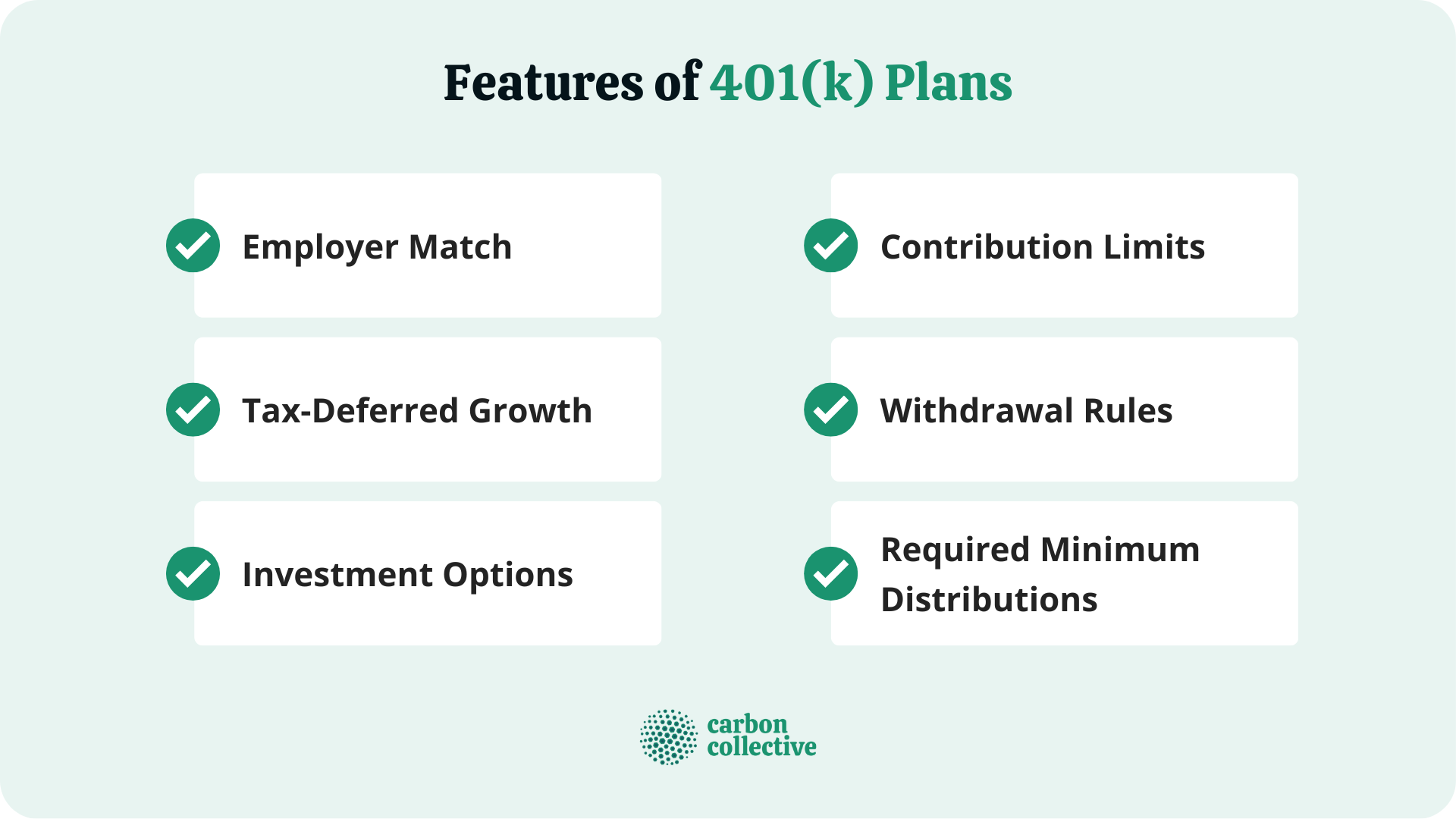What Is a 401(k) Plan?
A 401(k) is an employer-sponsored plan that allows employees to contribute part of their earnings toward retirement. These contributions offer tax advantages to the employees, which include tax deferral and, in some cases, employer contributions.
Earnings on the funds in a 401(k) will grow tax-deferred until withdrawn.
How Does a 401(k) Work?
A 401(k) is an arrangement between an employee and an employer that makes contributions toward retirement.
Individuals who usually sign up for this type of retirement savings have access to a 401(k) through their employer, particularly those paid on an hourly or salary basis.
Employers offer 401(k)s as part of their benefits package and can offer plans that provide various employer-matched contributions.
Types of 401(k) Plans
There are two main kinds of 401(k) plans. Employers can also use a 401(k) plan comparison tool or audit their existing 401(k) plan to make sure their plan is best suited for the company and employees in terms of fees, portfolio options, and level of support.
Traditional 401(k)
A traditional 401(k) plan is a tax-deferred retirement savings plan that allows employees to contribute a portion of their compensation. Employers may choose to match contributions made by the employee up to a set limit.
Contributions made to a traditional 401(k) are deducted from the employee's gross income, which means that the contributions come from the employee's payroll before taxes are calculated.
Hence, the contributions can be reported as a tax deduction for the particular tax year and will reduce the taxable income.
The funds in a traditional 401(k) grow tax-deferred until their withdrawal when they will be taxed as ordinary income.
Roth 401(k)
A Roth 401(k) is similar to a traditional 401(k) since it offers employees the opportunity to contribute a portion of their compensation toward retirement.
However, unlike a traditional 401(k), Roth contributions are made after taxes have been paid so they do not offer any immediate tax deduction.
Instead, the growth of the funds in the account is free from taxation as long as certain conditions set by the government are satisfied.
Features of 401(k) Plans
Employer Match
Employers may choose whether or not to match an employee's contribution for qualified plans. This means employers can decide if, how much, and when to provide matching contributions. Employers can also update their plans whenever they feel like it.
Contributions made by the employer to an employee's 401(k) plan may come in the form of a dollar amount, a percentage of salary, or a percentage of the contribution made by the employee.
For example, a company may decide that its employees who contribute a portion of their pre-tax salary toward their 401(k) plan will have the amount of their contribution matched by the company up to a certain percentage of their salary.
Therefore, an employer match is usually offered as part of a 401(k) savings plan and allows employees to defer taxes on earnings until they withdraw funds from the account after retirement.
In general, employers match contributions made by the employee up to a certain percentage of their salary.
For example, if an employee's gross income is $50,000 and they contribute 10% (or $5,000) in qualified plans through the employer match program, then their employer would also contribute $5,000.
Tax-Deferred Growth
Earnings on the funds in a 401(k) will grow tax-deferred until withdrawn. This means that employees do not pay income taxes on capital gains, dividends, or interest earned within their 401(k).
This is an advantage of 401(k) plans because it allows money to grow faster than if it were taxed.
However, this also has a disadvantage because if an individual withdraws funds from their 401(k) before they turn 59.5, they will most likely be required to pay ordinary income tax on top of a 10% early withdrawal penalty unless they qualify for an exemption.
Investment Options
A 401(k) plan allows investors to pick from investments offered by the employer or other financial organizations participating in the plan.
These options may include mutual funds, stocks, bonds, and money market accounts. These choices are usually limited by what is available through the plan offered by one's employer. Depending on how many investment options are available under a specific arrangement, this type of retirement savings can benefit multiple types of savers.
Contribution Limits
Like other retirement savings plans, 401(k) plans have a yearly contribution limit.
For 2022, the contribution limit is set at $20,500 for holders below 50. A catch-up contribution of $6,500 is allowed for individuals 50 and older. In 2023, the contribution limit is $22,500 with a catch-up contribution of $7,500 for those 50 or older.
These limits are set by the IRS to reduce the amount of taxes owed on contributions made during the calendar year.
Withdrawal Rules
To avoid penalties or taxation, withdrawals from a qualified plan must meet certain requirements before being reported as taxable income.
If an individual withdraws their money from a traditional 401(k), then the withdrawal is taxed as ordinary income and may be subject to fines and penalties if it occurs before they turn 59.5
Exceptions to this rule are as follows:
- Death
- Disability
- Qualified domestic relations order following a divorce
In cases where a plan holder needs to withdraw funds from the 401(k) account, they may have the option of borrowing from the 401(k) account, given the money owed will be paid back over a certain period.
If the loan is not paid back in time, it will be treated as an early withdrawal and would mean that the individual would have to pay income tax and any applicable penalties.
Required Minimum Distributions
The IRS requires that all 401(k) plan holders begin making withdrawals from their account once they reach 73, otherwise known as a required minimum distribution (RMD).
If an individual fails to distribute appropriately, they may incur a harsh penalty imposed by the IRS.
The purpose of required minimum distributions is to prevent individuals from transferring money into a 401(k) plan and then letting it accumulate until they pass, thus placing the tax burden on their beneficiaries.
The Bottom Line
Saving up for retirement is a challenging task that becomes more difficult the longer it takes to begin.
However, taking advantage of tax breaks and compounded interest can help offset some of the challenges associated with building up your savings account through a qualified plan, like a 401(k).
A great advantage of a 401(k) plan is that it may allow you to save more in a shorter amount of time because your money can grow tax-deferred.
A typical drawback is that a 401(k) plan requires a long-term commitment because an individual may not be able to access their money until they reach retirement age.
To open a 401(k) account, employees need to contact their employers or human resources department and confirm if the company offers such a plan. There are sustainable 401(k) plans that employers can set up to give employees more options around climate-focused investing.
The interested employee will be asked to fulfill basic information, designate the amount they would like to contribute to the plan, choose from available investments, and establish the beneficiary of the account.
FAQs
1. What is the main benefit of a 401(k)?
The main benefit of a 401(k) is that your money can grow tax-deferred.
2. What is the difference between a traditional and Roth 401(k)?
A traditional contribution reduces taxable income for the year in which it was made but is subject to taxes when withdrawals occur during retirement. Roth contributions do not reduce taxable income and are not taxed upon withdrawal as long as certain requirements are met.
3. What can I do with my 401(k) account if I decide to resign from my present employer who offers the plan?
You can leave your 401(k) account with the present employer, roll it over to a new employer's 401(k) or IRA, or cash out.
4. Which IRA is better: Roth or traditional?
The IRS does not have a preference for which you choose as long as they meet certain qualifications. Your decision will be based on your individual preferences and financial goals.
5. When am I required to begin taking RMD from my 401(k)?
Any individual who reaches 73 years of age must start taking RMD from their account.




